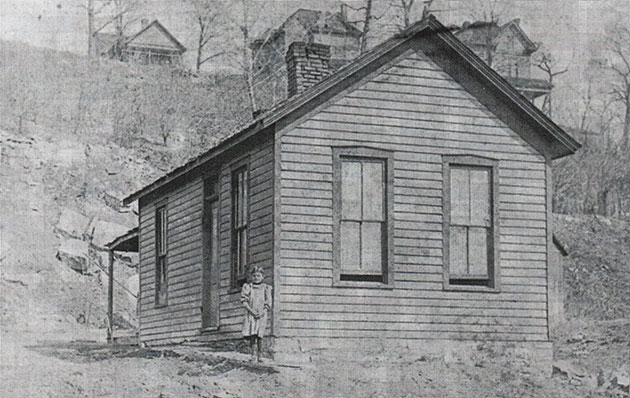
Before it became a major city park, Penn Valley was a deep ravine with 300 homes scattered across its hillsides, as seen in this photo from 1890. Photo courtesy of the Board of Park and Recreation Commissioners, as seen in the new book “Kansas City’s Parks and Boulevards.”
Midtown would be a completely different place today or perhaps would have disappeared without the influence of Kansas City’s unique park and boulevard system.
That’s the conclusion of Dona Boley, the coauthor of a new book called Kansas City Parks and Boulevards written with Patrick Alley.
If one of the reasons to study history is to learn from its lessons, Boley thinks there is an important one in the early vision for the park and boulevard system. It acted as an overall planning tool for the city’s development, helping city leaders see all parts of Kansas City, how they fit together, and how different neighborhoods could be connected.
“We need to reestablish a connection. It was a system. Everything was connected and intended to tie the city together. We have broken the ties,” she said.
The story she and Alley tell begins in the late 1860s when Kansas City was called the filthiest city in the country. It was covered in mud, its houses hemmed in by bluffs, with open waste cesspools and no water systems. It had wealthy residential enclaves but also slums and gullies full of shacks.
“But there was a vision of what Kansas City could become,” they wrote in the book. “A vision shaped over the next 40 years, making this rustic town a vibrant, healthy, well-planned community. An extensive parks and boulevard system was part of the plan.”
It traces the development of the 1893 Report of the Board of Park and Boulevard Commissioners, a plan that recognized the challenges of building a city in a town laid out on steep bluffs and hills. The report recommended the establishment of a park and boulevard system that eventually led to 90 miles of boulevards and 2500 acres of urban parks.
“It was a brilliant plan, and it worked,” Boley said. “Other cities would die to have what we have.”
The book traces the legal, political, and financial struggle to get the park system set up.
It also details the roles of four influential park advocates: Kansas City Star Publisher William Rockhill Nelson, who crusaded for the park plan; August Meyer, an early head of the park board who advocated for the type of parks he had seen in Europe; landscape architect George Kessler, who figured out how to overcome topographic challenges and turn them into assets; and attorney Delbert Haff, who worked out the legal details of the park system and argued its merits in the courts.
Because the park and boulevard system was developing at the same time Midtown neighborhoods were being created, it greatly impacted how this part of the city developed. As planners had hoped, wealthy Kansas Citians built their mansions along boulevards, and middle-class residents followed. The parks and boulevards encouraged local architects to create quality residences, and local green spaces have continued to be a draw for homeowners.
“I’m a firm believer we would not have our historic Midtown neighborhoods without the boulevards,” Boley said. She thinks neighborhoods, which suffered in the 1950s and 60s, could have all but disappeared without the stabilizing influence of the parks and boulevards.
Boley has also been involved in helping to reclaim several Midtown parks, including Gillham, Roanoke, and Penn Valley, and she said she is happy to see people getting involved and returning to those areas again.
“The bones are still there. How do we put the flesh back on?” she said.
Patrick Alley is an investment advisor and historian for his neighborhood. Boley is an advocate for the historical Parks and Boulevard System. They also coauthored Images of America: Kansas City’s Historic Hyde Park and are both Hyde Park residents.
Kansas City’s Parks and Boulevards, published by Arcadia Publishing, is available at local retailers, online bookstores or through Arcadia Publishing at www.arcadiapublishing.com.
I believe in Kansas cities return. I love my neighborhood in volker. I love the inner city
I think we all take the Parks and Blvds for granted.I love Midtown, and I’m a firm believer in holding true to the original integrity of our incredible Blvd System